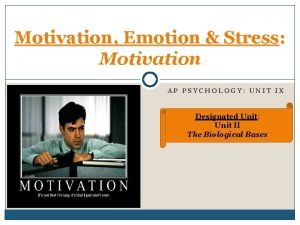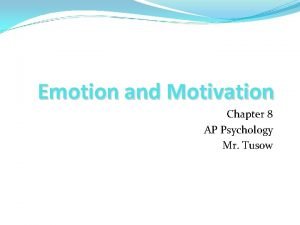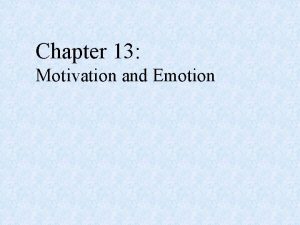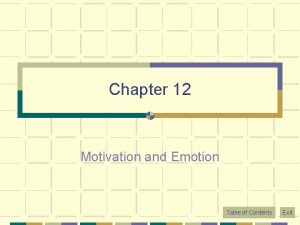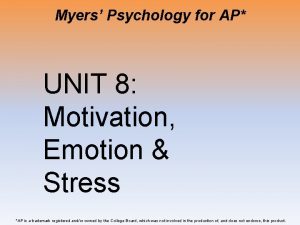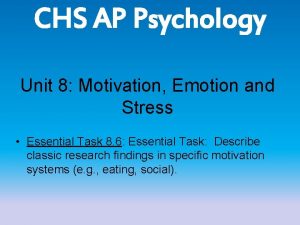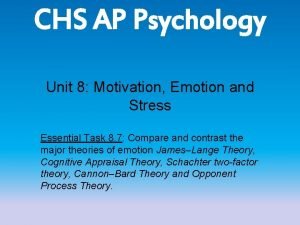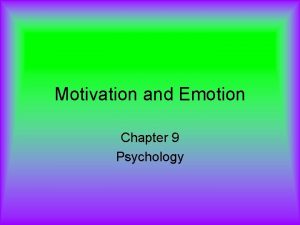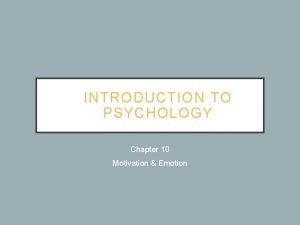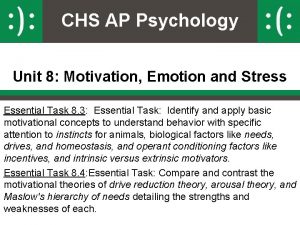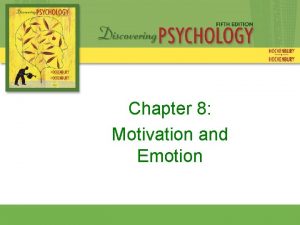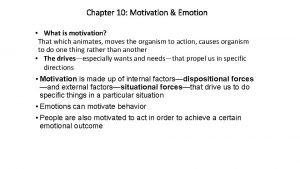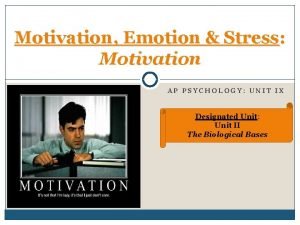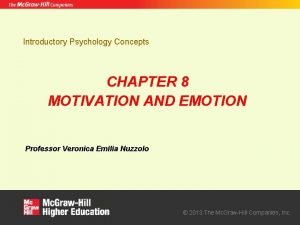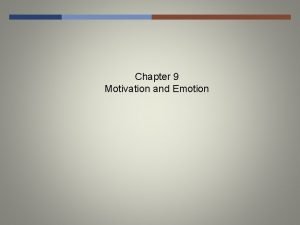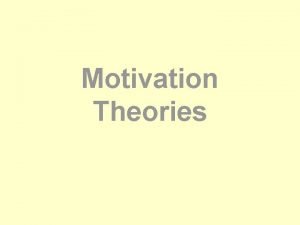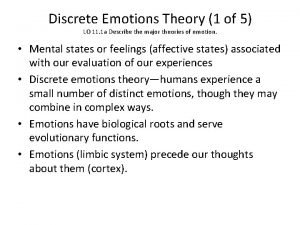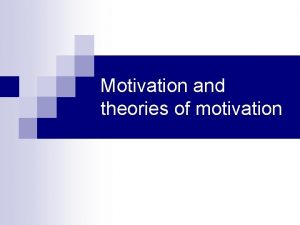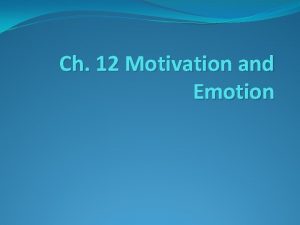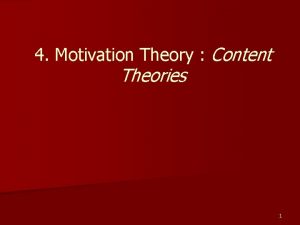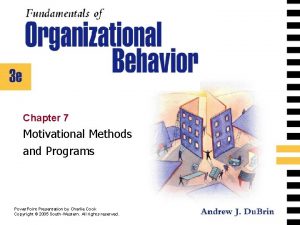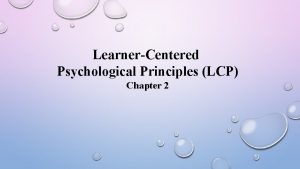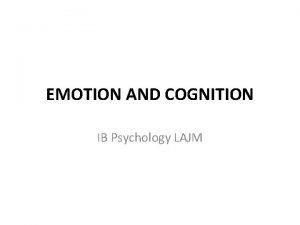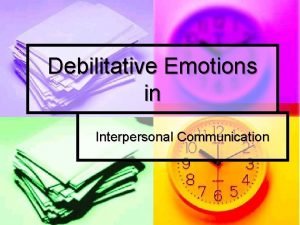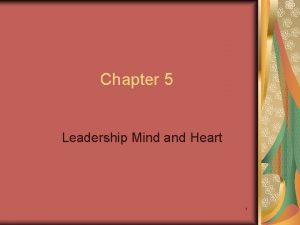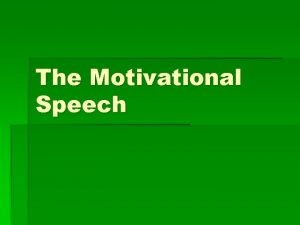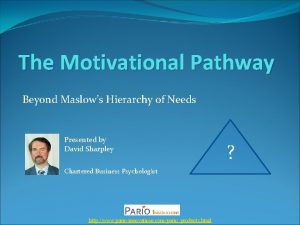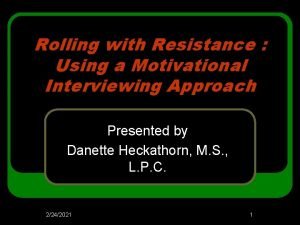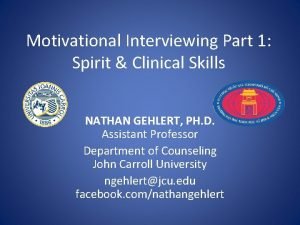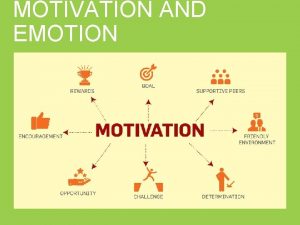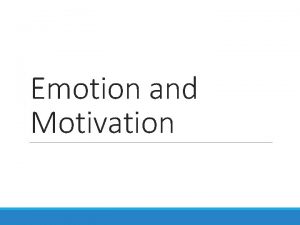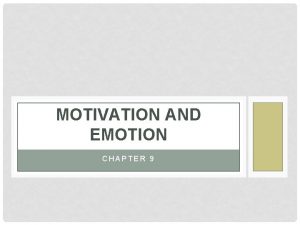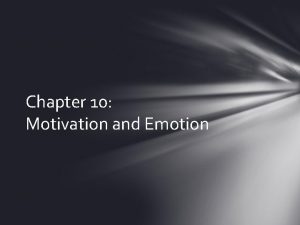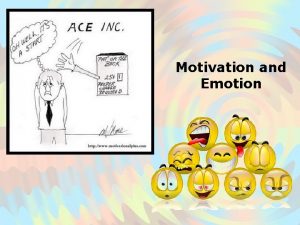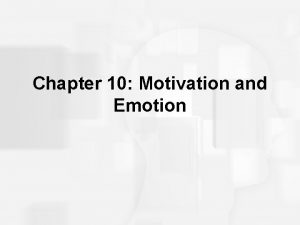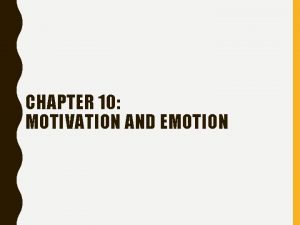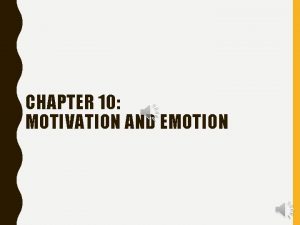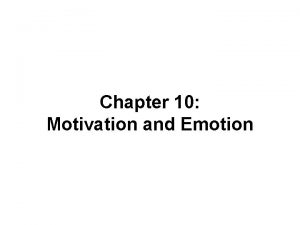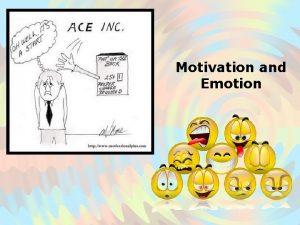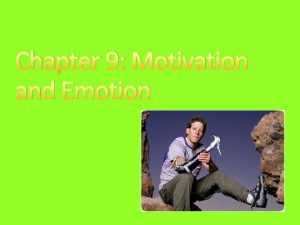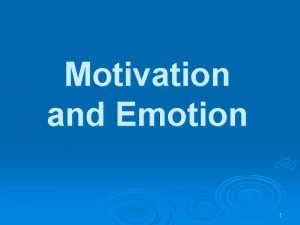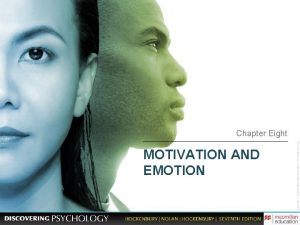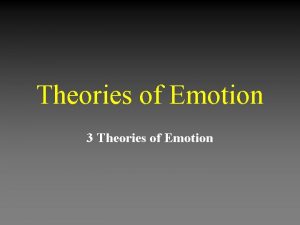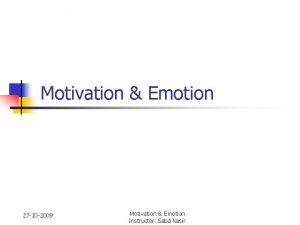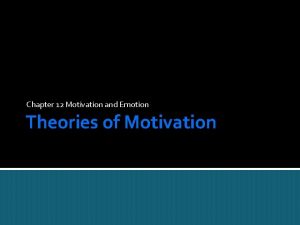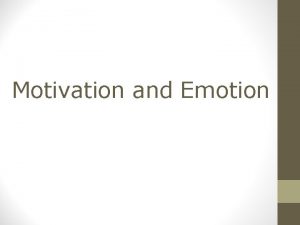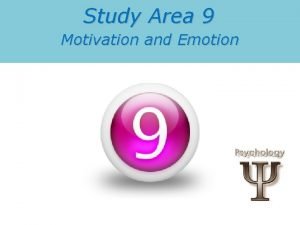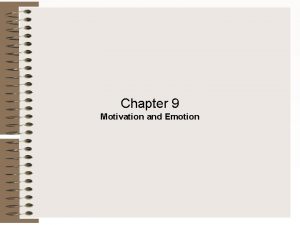CH 10 MOTIVATION AND EMOTION MOTIVATIONAL THEORIES AND











































- Slides: 43

CH. 10: MOTIVATION AND EMOTION

MOTIVATIONAL THEORIES AND CONCEPTS • Motives – needs, wants, desires leading to goaldirected behavior; anything that pushes you to perform a behavior. • Instincts - species specific pre-programmed behavior patterns designed to aid in survival and adaptation. • Drive-reduction theory – Clark Hull’s model; states that physiological needs create a state of arousal that needs to be satisfied in order to bring an organism back into homeostasis, or internal balance. Only works for biological motivation and doesn’t take into account other motivational forces.

MOTIVATIONAL THEORIES AND CONCEPTS • Arousal theory states that motivation is based on differing levels of optimum arousal. Some people love high arousal and engage in behaviors to gain that arousal (skydiving, mountain climbing, etc. ). Other people prefer a much more sedate lifestyle, where activities such as the above would be unthinkable. • Yerkes-Dodson Law asserts that task performance increases with physiological and/or mental arousal/stress, but only up to a point. When levels of arousal become too high or the task is very difficult, performance begins to first plateau and then eventually decrease. The process is often illustrated graphically as a curvilinear, inverted Ushaped curve which increases and then decreases with higher levels of arousal (see next frame)

MOTIVATIONAL THEORIES AND CONCEPTS

MOTIVATIONAL THEORIES AND • Incentive theories – motivation created by potential rewards CONCEPTS gained from external sources (extrinsic motivation) or internal sources (intrinsic motivation). Most incentive laden motivations contain elements of both. • “I work because they pay me. ” (extrinsic), or “I play basketball every afternoon because I love to play basketball. ” (intrinsic) • Evolutionary theories – all motivational forces are centered around maximizing reproductive success. So, according to this view, the above examples would be more like the following: • “I play basketball because it’s the most fun way to stay in shape so girls might be attracted to me. ” or “I work to pay bills because girls are attracted to stable, ambitious men. ”

MOTIVATIONAL THEORIES AND CONCEPTS • Maslow’s Hierarchy of Needs theory – Some needs take priority over others. For example, satisfying hunger and thirst are much more important than gaining money and establishing a successful business. Only after you have taken care of hunger and thirst can you turn your attention to other things. Abraham Maslow created a motivational theory based on this type of need prioritization. On the following frame, you will see the hierarchy illustrated by using a hierarchical pyramid.

MASLOW’S HIERARCHY OF NEEDS THEORY

Figure 10. 2 The diversity of human motives

HUNGER AND EATING: BIOLOGICAL FACTORS • In the early 1900’s, Walter Cannon and A. L. Washburn hypothesized that there is an association between stomach contractions and the experience of hunger; Cannon hypothesized a causal relationship, yet people who have their stomachs removed still experience hunger. This realization led to more complicated theories focusing on the brain, blood sugar, and hormones. Researchers soon discovered that the hypothalamus, particularly two areas called the Lateral Hypothalamus (LH) and the Ventromedial Nucleus of the Hypothalamus (VMH), were important in stimulating and then quieting hunger motivation. The LH was thought to be the hunger center, while the VMH was thought to be the satiety (hunger

HUNGER AND EATING: BIOLOGICAL FACTORS • Subsequent research indicated that this was an oversimplified picture, although the LH and VMH are key parts of the hunger circuit, they are not the only elements. • The Paraventricular Nucleus of the Hypothalamus has recently been implicated as another influential part of the hunger circuit, as it triggers the release of oxytocin, a pituitary hormone that helps to stimulate (more) and retard(less) hunger. • New research has found that increased levels of Ghrelin play a particularly crucial role in stimulating hunger. Ghrelin performs double duty as a neurotransmitter in the nervous system and as a hormone in the endocrine system. In both systems, elevated Ghrelin levels are associated with increased food intake.

HUNGER AND EATING: BIOLOGICAL FACTORS • Other research has focused on the role of blood glucose and digestive regulation on hunger; when blood sugar goes down, hunger goes up. Glucostatic theory proposed that fluctuations in blood glucose level are monitored in the brain by Glucostats – neurons sensitive to glucose in the surrounding fluid. It appears likely that hunger is regulated, in part, through glucostatic mechanisms. • Hormones circulating in the blood also appear to be related to hunger. Insulin, secreted by the pancreas, must be present for cells to use blood glucose. Increases in insulin increase hunger, and the mere sight and smell of food has been shown to increase insulin. • Recently, a new hormone, leptin, has been discovered to be released from fat cells into the bloodstream. Leptin is believed to

Figure 10. 3 The hypothalamus

HUNGER AND EATING: ENVIRONMENTAL FACTORS • Learned preferences and habits • Exposure – Studies show that people like foods that are familiar to them; dog meat is a delicacy in some parts of the world yet we wouldn't think about eating dog here in America. We also learn about when we are supposed to eat. Notice that you have been trained by your school schedule to be hungry right around 11: 30, or by your parents schedule regarding dinner time. • Food-related cues, such as appearance, odor, how much effort is required to procure the food. If it looks good, smells good, and doesn’t require too much effort on your part, hunger motivation skyrockets. • Psychosocial cues: People also are motivated to eat when others are eating, to fit in socially by doing what everyone else is doing. Stress has a high correlative link between heightened negative arousal/ emotion and overeating.

THE ROOTS OF OBESITY § Genetic predispositions: Lose weight on a diet, and then gain it right back sound about the way it usually goes? The reverse is also true. Intentionally put on weight and you’ll have a hard time keeping it on. Our bodies may have a set point, or natural point of stability in body weight. This appears to be related to fat cell levels. When fat stores slip below a crucial level, hunger increases and metabolism decreases. A new theory called settling-point theory proposes that weight hovers near the level at which the constellation of factors that determine food consumption and energy expenditure achieve an equilibrium. Thus, according to this theory, weight remains stable as long as there are no durable changes in any of the factors that influence it.

THE ROOTS OF OBESITY • Evolutionary explanations – For much of human history competition for food was fierce and food supplies were unreliable. Eat w/e you can was pretty much the MO. Evolution has yet to catch up to the fact that today, the vast majority of humans live in environments where food is abundant and reliable. § Dietary restraint § Mortality rates among people who are moderately overweight are not elevated in today’s population § Can become a problem with chronic dieters who restrain themselves from eating and go hungry much of the time, but they are constantly thinking about food. When they give in, they become disinhibited and eat to excess, often referred to as the “I’ve already blown it, so the heck with it” problem.

EATING DISORDERS Anorexia Nervosa – An obsessive-compulsive etiology that is very specific; it is characterized by an obsessive fear of gaining weight and a distorted self image, the compulsion of course, is to starve themselves. It most often has its onset in adolescence and is most prevalent among adolescent girls. Bulimia Nervosa – similar to Anorexia Nervosa, Bulimia is characterized by binge eating and purging or consuming a large amount of food in a short amount of time, followed by an attempt to rid oneself of the food consumed, usually by purging (vomiting or through the use of laxatives/diuretics) or excessive exercise. As with Anorexia, it is at root an obsessivecompulsive issue that most often has its onset in adolescence and is most prevalent among adolescent girls and young women. In both cases, there is very high co-morbidity with Mood disorders as well as Anxiety disorders.

SEXUAL MOTIVATION AND BEHAVIOR • Hormonal regulation: Hormones exert considerable influence on sexual behavior in many animals, but human sexuality is influenced by much more than hormones. Research suggests that hormones do have at least a small role in human sexual behavior, as testosterone fluctuations are correlated with sexual activity. • Estrogens – female sexual hormones • Androgens – male sexual hormones • Testosterone – the primary male androgen that contributes to sexual development and sexual behavior. • Pheromones - chemicals secreted by one animal that affects the behavior of another, usually detected through the sense of smell. Research on pheromones in humans is inconclusive with regard to sexual desire; however, they have been linked to synchronized ovulation among women who live or work together

SEXUAL MOTIVATION AND BEHAVIOR • Aphrodisiacs - Viagra is not a sexual stimulant, it improves performance, but doesn’t provide desire. Pharmaceutical companies are, however, working on developing aphrodisiacs, and there are promising leads. • Erotic materials –Erotic materials have been shown to elevate sexual desire only for a few hours, but they may have an enduring effect on attitudes about sex. Aggressive pornography make sexual coercion seem less offensive and may contribute to date rape. • Attraction to a partner and the Coolidge effect – Obviously, one must be physically attracted to one’s partner for sexual desire to be in play. However, even the most attractive people tire of one another after awhile. The phenomenon of a new sexual partner reviving sexual interest is termed the Coolidge effect.

SEXUAL MOTIVATION AND BEHAVIOR: • Evolutionary factors - these theories hinge on parental investment, with females being more discriminating in choosing partners and less likely to engage in casual sex. This has been used to explain sex differences such as males thinking about sex more frequently, males emphasizing youthfulness and attractiveness in a potential partner, and females emphasizing status and financial

Figure 10. 8 Parental investment theory and mating preferences

Figure 10. 9 The gender gap in how much people think about sex

THE MYSTERY OF SEXUAL ORIENTATION • Heterosexual – Bisexual – Homosexual • Definitions • Heterosexual – exclusively attracted to opposite sex people • Homosexual – exclusively attracted to same sex people • Bisexual – attracted to both sexes • The Kinsey Continuum – next frame shows a detailed version of the scale in graphic form. • Data on the prevalence of homosexuality suggests that 5 -8% of the population may have a homosexual orientation.

Figure 10. 14 Homosexuality and heterosexuality as endpoints on a continuum

THE MYSTERY OF SEXUAL ORIENTATION • Theories explaining homosexuality: • Environmental - Many environmental theories explaining homosexuality have been put forth historically. Freud held that a person must identify with the same sexed parent, or homosexuality results. Behaviorists assert that homosexuality is learned through conditioning. Research has failed to support either theory. What has been found is that most men and women with `homosexual orientations can trace their leanings back to early childhood, suggesting a biological basis. • Biological - research suggests that there is a genetic predisposition to homosexuality, possibly based on the X chromosome. Anatomical differences between gay and straight men in the size of the anterior hypothalamus have also been found. This structure is larger in men than in women, and this study showed that gay men had a 50% smaller AH than straight men. • Interactionist - holds that genes and prenatal hormones shape a child’s temperament, which initiates a chain of events that ultimately shapes sexual orientation.

Figure 10. 16 How common is homosexuality?

THE HUMAN SEXUAL RESPONSE • William Masters and Virginia Johnson conducted groundbreaking research in the 1960 s, using physiological recording devices to monitor the bodily changes of volunteers engaging in sexual activity. They outlined 4 stages in the sexual response cycle. • The excitement phase is the initial arousal, which escalates quickly. Muscle tension, respiration rate, heart rate and blood pressure increase. Vasocongestion is the process that causes the engorgement of blood vessels in the genitals, leading to an erection in men and a tighter glove and natural lubrication in women. • The plateau phase occurs when physiological arousal continues to build, but at a slower pace.

THE HUMAN SEXUAL RESPONSE • The orgasm phase occurs when sexual arousal reaches its peak intensity and is discharged in a series of muscular contractions that pulsate through the pelvic area. The experience of orgasm is very similar for men and women, but women can be multiorgasmic. On the other hand, they are more likely to engage in intercourse without experiencing an orgasm. • The resolution phase is characterized by subsiding physiological arousal. Men experience a refractory period after orgasm, when they are largely unresponsive to further stimulation. This may last from a few minutes to a few hours and increases with age.

Figure 10. 7 The gender gap in orgasm consistency

ACHIEVEMENT MOTIVATION • Achievement motivation involves the need to excel, especially in competition with others. People who are relatively high in the need for achievement work harder and more persistently, they tend to delay gratification well and to pursue competitive careers. • Situational factors have been shown to influence achievement motivation, causing it to increase when the probability of success and the incentive value of success are high. Additionally, the pursuit of achievement can be influenced by a fear of failure, so that the motive to avoid failure stimulates success, but only at reduced risk and challenge; the fear of failure restrains the person from challenging themselves, so

THE ELEMENTS OF EMOTIONAL EXPERIENCE • There are three elements to an emotional experience, which will be explained on the next few slides: • Cognitive experience • Physiological experience • Behavioral experience • Display Rules are sociocultural rules regarding when, where, and what types of emotions can socially displayed by people of each sex. For example, it is considered to be awkward in America if a man is seen crying in public, whereas in Asia it is not only a normal event but is actually encouraged.

CULTURE AND EMOTION

CULTURE AND EMOTION • New research shows that Japanese culture encourages the experience of socially engaging emotions (such as friendly feelings, sympathy, and guilt) more than North American culture, and Japanese participants report experiencing these types of emotion more. In contrast, North American culture encourages socially disengaging emotions (such as pride, and anger) more than Japanese culture, and North American subjects report experiencing these kinds of emotion more. Any questions as to which culture is the more aggressive and violent?

CULTURE AND EMOTION • Some basic categories of emotion that are universally understood in Western cultures appear to go unrecognized—or at least unnamed—in some non. Western cultures. For example, Tahitians have no word that corresponds to sadness. Many non-Western groups, including the Yoruba of Nigeria, the Kaluli of New Guinea, and the Chinese, lack a word for depression. The concept of anxiety seems to go unrecognized among Eskimos, and the Quichua of Ecuador lack a word for remorse. However, a lack of words for emotional concepts does not necessarily mean that those emotions are not recognized in a

THE ELEMENTS OF EMOTIONAL EXPERIENCE • 1) The cognitive component of emotion involves subjective feelings that have an evaluative aspect. Researchers have, in the past, focused primarily on negative emotions, consistent with the bias in the field of psychology toward studying pathology, weakness, and suffering. In recent years, however, a group of psychologists led by Martin Seligman have advocated for positive psychology, focusing an increasing amount of research on contentment, well-being, human strength, and positive emotion.

THE ELEMENTS OF EMOTIONAL EXPERIENCE • 2) The physiological arousal associated with emotion occurs through the actions of the autonomic nervous system. The autonomic nervous system is responsible for the highly emotional fight-or-flight response. The galvanic skin response (GSR) measures autonomic activation, meaning that there is a device that measures autonomic physiological fluctuations such as heart rate, muscle contraction, body temperature, and other biofeedback mechanisms. This device, when used while interrogating someone, is called a polygraph or lie detector. Polygraph tests measure physiological responses, which are allegedly caused by reactions to the questions that are posed. Whether these reactions are caused by deceit or not is not proven; in fact, they are so inaccurate that they are not reliable enough to be submitted as evidence in American courtrooms. In the brain, the limbic system is the emotional circuit (the hypothalamus, the amygdala, and adjacent structures); Joseph Le. Doux (1996) has shown that the amygdala plays a particularly central role in modulating emotions.

THE ELEMENTS OF EMOTIONAL EXPERIENCE • 3) Behaviorally, emotions are expressed through body language and facial expressions. Research indicates considerable cross-cultural similarities in the ability to differentiate facial expressions of emotion. The facialfeedback hypothesis holds that facial muscles send signals to the brain that help it recognize the emotion being experienced. For example, a person’s smile has different qualities and nuances depending on the situation. A joyful smile is not the same as a bitterly ironic smile. • Cross-cultural similarities have also been found in the cognitive and behavioral components, although display rules, or norms for regulating appropriate expression of emotion, vary from culture to culture.

Figure 10. 22 The amygdala and fear

THEORIES OF EMOTION • Common sense says that the emotion of fear causes physiological changes in the body (increased heart rate, perspiration, etc. ). • James-Lange theory – postulated that the common sense idea was wrong, and that the opposite was true – in other words, emotional experiences only occur after physiological changes occur i. e. I feel afraid because my pulse is racing. • Cannon-Bard theory - Because thalamus sends signals simultaneously to the cortex and the autonomic nervous system, emotional experiences and physiological changes occur simultaneously.

THEORIES OF EMOTION • Schacter’s Two-Factor Theory - When a person becomes stimulated by an event, they looks to external and internal cues to decide what to feel. Once a cognitive appraisal of the situation has been made (based on both internal physiological changes and external sensory perceptions), then the experience of emotion occurs. • Evolutionary Theories propose that emotions are innate reactions to external stimuli and require little or no cognitive interpretation.

Figure 10. 24 Theories of emotion

HAPPINESS • Common sense notions are usually incorrect • Income, age, parenthood, intelligence, and attractiveness largely uncorrelated • Physical health, good social relationships, religious faith, and culture modestly correlated • Love and a healthy marriage/family life, work satisfaction, and positive/optimistic personality strongly correlated

SUBJECTIVE WELL-BEING • Objective realities are not as important as subjective feelings/perceptions • When it comes to happiness everything is relative • People are surprisingly bad at predicting what will make them happy • People often adapt to their circumstances • Hedonic adaptation occurs when the mental scale that people use to judge the pleasantness/unpleasantness of their experiences shifts so that their neutral point, or baseline for comparison, changes.

Figure 10. 30 Possible causal relations among the correlates of happiness
 Hormones ap psychology
Hormones ap psychology 2 factor theory of emotion
2 factor theory of emotion Chapter 13 motivation and emotion
Chapter 13 motivation and emotion Chapter 12 motivation and emotion
Chapter 12 motivation and emotion Myers psychology unit 8
Myers psychology unit 8 Unit 8 motivation and emotion
Unit 8 motivation and emotion Ap psychology unit 8 test
Ap psychology unit 8 test Carroll izard 10 basic emotions
Carroll izard 10 basic emotions Paul ekman universal facial expressions
Paul ekman universal facial expressions Homeostasis ap psychology
Homeostasis ap psychology Cognitive appraisal
Cognitive appraisal Chapter 10 motivation and emotion
Chapter 10 motivation and emotion Unit 8 motivation and emotion
Unit 8 motivation and emotion Ap psychology motivation and emotion activities
Ap psychology motivation and emotion activities Chapter 8 motivation and emotion
Chapter 8 motivation and emotion Incentive theory ap psychology
Incentive theory ap psychology Chapter 9 motivation and emotion quiz
Chapter 9 motivation and emotion quiz Mayos motivational theory
Mayos motivational theory 2 factor theory of emotion
2 factor theory of emotion Discrete emotion theory
Discrete emotion theory What is motivation
What is motivation Nnn motivation
Nnn motivation Content theories of motivation
Content theories of motivation Incentive theories of motivation
Incentive theories of motivation Definition of motivation in organisational behaviour
Definition of motivation in organisational behaviour Content theories of motivation
Content theories of motivation X and y theory of motivation
X and y theory of motivation Sales force motivation ppt
Sales force motivation ppt Nnn motivation
Nnn motivation Chapter 7 motivation concepts
Chapter 7 motivation concepts Site:slidetodoc.com
Site:slidetodoc.com What are the factors of lcp
What are the factors of lcp Emotion and cognition ib psychology
Emotion and cognition ib psychology What are facilitative emotions
What are facilitative emotions Leadership mind and emotion
Leadership mind and emotion General motivational speech
General motivational speech Motivational pathway
Motivational pathway Motivational speech on teamwork
Motivational speech on teamwork Mi rolling with resistance
Mi rolling with resistance Motivational interviewing
Motivational interviewing Motivational interviewing dears
Motivational interviewing dears Motivational interviewing schizophrenia
Motivational interviewing schizophrenia Motivational interviewing basics
Motivational interviewing basics Motivational email
Motivational email
